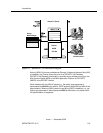
Introduction
Issue 1 — December 2002
DEFNETM.PDF R1.2
1-2
Organization of This Document
This document is organized as follows:
Chapter 1, "Introduction" provides a list of chapters in this document, an overview
of the DEFINITY G3 PBX Driver, terminology important to the understanding of
Computer-Telephony Integration (CTI) and a list of related documents.
Chapter 2, "Security and Configuration" describes security measures and how to
reconfigure the G3PD using the G3 PBX Driver Configuration utility. Instructions
are also provided on how to use the PBX Link Change utility to change the IP
address or hostname of an active link.
Chapter 3, "Maintenance" describes the tools that can be used to observe and
test the G3PD. An Operations, Administration, and Maintenance (OA&M) utility,
the DEFINITY G3PD Administrator utility, can be used from a Microsoft Windows
2000, Windows NT (4.0 or later), Windows XP, or Windows 95 machine to perform
OA&M tasks.
Chapter 4, "Troubleshooting" describes problems that can occur with the
DEFINITY G3 PBX Driver (G3PD), the switches, and the switch links, and
suggests possible solutions to these problems.
Overview of DEFINITY G3 PBX Driver
The DEFINITY G3 PBX Driver (G3PD) allows Telephony Services applications to
communicate with a DEFINITY G3 PBX.
n Telephony Services applications access the G3PD through Telephony
Services (the security database and advertised services).
n CVLAN applications bypass Telephony Services and access an ASAI link
directly using CallVisor Adjunct Switch Application Interface (ASAI)
messages.
The primary function of the G3PD is to interpret Computer Supported
Telecommunications Application (CSTA) requests made by Telephony Services
applications and to forward them to the PBX. To do this, the G3PD converts the
CSTA requests into CallVisor ASAI messages, and uses the CVLAN API to send
and receive these messages across an ASAI link connecting your Tserver to the
DEFINITY ECS system. Customer applications on the Tserver can use this API
directly. In addition, clients can access the API with CVLAN. See Figure 1-1.


















